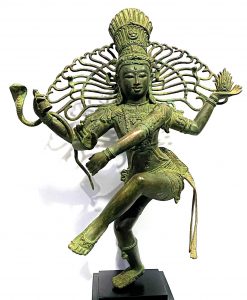Lord Of The Dance
A very early reference to dancing was made by Alexander the Great. He said his warriors should dance, but he was not referring to the sexually oriented dances shown in the films of him, he wanted them to dance as warriors making the full movements made in fighting with swords, spears or unarmed. These quick and full movements kept his men limber and fast in battle. It worked for he conquered many different armies.
Dancing was also seen as a holy thing taught by the gods.
You cannot see it but Shive has a female breast under his left arm, showing he/she is a complete being and not as many humans are a spilt in half beings. Shiva is shown as the source of all movement within the cosmos, represented by the arch of flames. It is apocalypse and creation, and is Life itself as it creates, dies and recreates as we see in the seasons. The cosmic dance of Shiva symbolises the interplay of dynamic and static divine energy flow, containing the five principles of eternal energy — creation, preservation, destruction, illusion and emancipation.

In all ages the dance continues, but humans can become the dancers moved by the Divine and not by their own own attempts at dancing. For when we surrender to the divine to move us we are shown the splendour of our own living process.
Sufi whirling (or Sufi spinning) is a form of
Sama or physically active
meditation which originated among some Sufis, and which is still practised by the Sufi
Dervishes of the
Mevlevi order. It is a customary dance performed within the
sema, through which dervishes (also called
semazens, from
Persian سماعزن) aim to reach the source of all perfection, or
kemal. This is sought through abandoning one’s
nafs,
egos or personal desires, by listening to the music, focusing on
God, and spinning one’s body in repetitive circles, which has been seen as a symbolic imitation of planets in the
Solar System orbiting the sun.
[141]Jaladin Rumi –
I died to the mineral state and became a plant,
I died to the vegetal state and reached animality,
I died to the animal state and became a man,hen what should I fear? I have never become less from dying.
At the next charge (forward) I will die to human nature,
So that I may lift up (my) head and wings (and soar) among the angels,
And I must (also) jump from the river of (the state of) the angel,
Everything perishes except His Face,
Once again I will become sacrificed from (the state of) the angel,
I will become that which cannot come into the imagination,
Then I will become non-existent; non-existence says to me (in tones) like an organ,
Truly, to IT is our return
But the beginning of Sufi whirling was started by Jalaluddin Rumi himself. He found that when he held onto a pole and spun around it fast he would enter into wider awareness because it caused dizziness. It seems that slowly became the whirling dance of the dercvishes.


In the Old Testament King David danced naked in the streets.
2 Samuel 6:14-22 – And David danced before the Lord with all his might, wearing no garment.
[a] 15 So David and all the people of Israel brought up the Ark of the Lord with shouts of joy and the blowing of rams’ horns.
20 When David returned home to bless his own family, Michal, the daughter of Saul, came out to meet him. She said in disgust, “How distinguished the king of Israel looked today, shamelessly exposing himself to the servant girls like any vulgar person might do!”
21 David retorted to Michal, “I was dancing before the Lord, who chose me above your father and all his family! He appointed me as the leader of Israel, the people of the Lord, so I celebrate before the Lord. 22 Yes, and I am willing to look even more foolish than this, even to be humiliated in my own eyes! But those servant girls you mentioned will indeed think I am distinguished!”

King David dancing – He was doing it by letting go of all his power, his status as a king, and had no preconceptions or beliefs, and so was led from within by the divine..
The
Hittites are shown in a sacred processional dance in a
c. 1200 BC rock inscription at the sanctuary of
Yazılıkaya, near their city of
Hattusa, in
Cappadocia. A group of men wearing conical hats and tip-tilted shoes, and a group of women, dance in a running step towards a group of named gods and goddesses.
[15]In ancient Greece, sacred dance was widespread; indeed, it formed a part of almost all worship, and the gods
Apollo,
Ares,
Dionysus and
Pan are all described as dancers, while other deities such as
Artemis were described as dancing with their companions.
[16]
The Hawaiian
Hula dances to
Pele, the volcano goddess, survive, whereas European
maypole dances have lost their meaning as tree-worship and survive only as folk tradition.
[9]
Lewis Farnell, an anthropologist, observed that sacred dance has an “extraordinary uniformity” among indigenous peoples all over the world.
 In all ages the dance continues, but humans can become the dancers moved by the Divine and not by their own own attempts at dancing. For when we surrender to the divine to move us we are shown the splendour of our own living process.
In all ages the dance continues, but humans can become the dancers moved by the Divine and not by their own own attempts at dancing. For when we surrender to the divine to move us we are shown the splendour of our own living process.